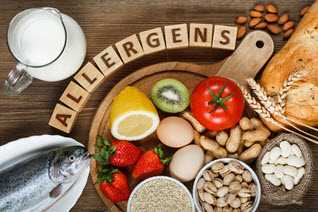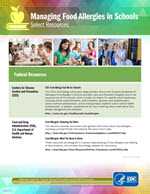Food Allergies in Schools
Food Allergy Facts
 Food allergies are a growing food safety and public health concern that affect an estimated 4%–6% of children in the United States.1, 2 There is no cure for food allergies and reactions can be life threatening. Strict avoidance of the food allergen is the only way to prevent a reaction. However, since it is not always easy or possible to avoid certain foods, staff in schools and early care and education programs (ECE) should develop plans for preventing an allergic reaction and responding to a food allergy emergency, including anaphylaxis. Early and quick recognition and treatment can prevent serious health problems or death.
Food allergies are a growing food safety and public health concern that affect an estimated 4%–6% of children in the United States.1, 2 There is no cure for food allergies and reactions can be life threatening. Strict avoidance of the food allergen is the only way to prevent a reaction. However, since it is not always easy or possible to avoid certain foods, staff in schools and early care and education programs (ECE) should develop plans for preventing an allergic reaction and responding to a food allergy emergency, including anaphylaxis. Early and quick recognition and treatment can prevent serious health problems or death.
What is a Food Allergy?
 A food allergy occurs when the body has a specific and reproducible immune response to certain foods.3 The body’s immune response can be severe and life threatening, such as anaphylaxis. Although the immune system normally protects people from germs, in people with food allergies, the immune system mistakenly responds to food as if it were harmful.
A food allergy occurs when the body has a specific and reproducible immune response to certain foods.3 The body’s immune response can be severe and life threatening, such as anaphylaxis. Although the immune system normally protects people from germs, in people with food allergies, the immune system mistakenly responds to food as if it were harmful.
Eight foods or food groups account for 90% of serious allergic reactions in the United States: milk, eggs, fish, crustacean shellfish, wheat, soy, peanuts, and tree nuts.3
The symptoms and severity of allergic reactions to food can be different between individuals, and can also be different for one person over time. Anaphylaxis is a sudden and severe allergic reaction that may cause death.4 Not all allergic reactions will develop into anaphylaxis.
- Children with food allergies are two to four times more likely to have asthma or other allergic conditions than those without food allergies.1
- The prevalence of food allergies among children increased 18% during 1997-2007, and allergic reactions to foods have become the most common cause of anaphylaxis in community health settings.5
- Although difficult to measure, research suggests that approximately 4% of children and adolescents are affected by food allergies.2
Managing Food Allergies at School
Voluntary Guidelines for Managing Food Allergies in Schools and Early Care and Education Programs
CDC in consultation with the U.S. Department of Education, several federal agencies, and many stakeholders, developed Voluntary Guidelines for Managing Food Allergies [PDF – 10MB] to provide practical information and recommendations for each of the five priority areas that should be addressed in each school’s or ECE program’s Food Allergy Management Prevention Plan:
- Ensure the daily management of food allergies in individual children.
- Prepare for food allergy emergencies.
- Provide professional development on food allergies for staff members.
- Educate children and family members about food allergies.
- Create and maintain a healthy and safe educational environment.
Tool Kit for Managing Food Allergies in Schools
 CDC created a tool kit to help schools implement the Voluntary Guidelines for Managing Food Allergies [PDF – 10MB] in order to prevent and manage severe allergic reactions in schools. The tool kit includes tip sheets, training presentations, and podcasts for school superintendents, administrators, teachers and paraeducators, school nutrition professionals, school transportation staff, and school mental health professionals.
CDC created a tool kit to help schools implement the Voluntary Guidelines for Managing Food Allergies [PDF – 10MB] in order to prevent and manage severe allergic reactions in schools. The tool kit includes tip sheets, training presentations, and podcasts for school superintendents, administrators, teachers and paraeducators, school nutrition professionals, school transportation staff, and school mental health professionals.
Managing Food Allergies in Schools
- Select Resources for Schools [PDF – 802 KB]
- Schools PowerPoint® Presentation [PPT – 5.7 MB] | [PDF – 3.2 MB]
The Role of School Administrators
- School Administrators Tip Sheet [PDF – 804 KB]
- School Administrators PowerPoint® Presentation [PPT – 4.37 MB] | [PDF – 2.50 MB]
- School Administrators Podcast
The Role of Superintendents
The Role of School Nutrition Professionals
- School Nutrition Professionals Tip Sheet [PDF – 668 KB]
- School Nutrition Professionals PowerPoint® Presentation [PPT – 4.22 MB] | [PDF – 1.97 MB]
- School Nutrition Professionals Podcast
The Role of Teachers and Paraeducators
- Teachers and Paraeducators Tip Sheet [PDF – 619 KB]
- Teachers and Paraeducators PowerPoint® Presentation [PPT – 3.57 MB] | [PDF – 1.89 MB]
- Teachers and Paraeducators Podcast
The Role of School Mental Health Professionals
- School Mental Health Professionals Tip Sheet [PDF – 596 KB]
- School Mental Health Professionals PowerPoint® Presentation [PPT – 3.24 MB] | [PDF – 1.67 MB]
- School Mental Health Professionals Podcast
The Role of School Transportation Staff
- School Transportation Staff Tip Sheet [PDF – 778 KB]
- School Transportation Staff PowerPoint® Presentation [PPT – 4.13 MB] | [PDF – 2.34 MB]
- School Transportation Staff Podcast
The Role of School Nurses
Resources
Food Allergy Health Information
Food Allergies: What You Need to Know
Safe at School and Ready to Learn: a Comprehensive Policy Guide for Protecting Students with Life-Threatening Food Allergies [PDF – 4.8 MB]
State Guidelines for Managing Food Allergies in Schools
Food Allergy Action Plan [PDF – 615 KB]
Food Allergies and Schools: Keeping Students Safe and Ready To Learn
Managing Food Allergies in the School Setting
Food Allergy and Anaphylaxis: A National Association of School Nurses Tool Kit
References
- Branum AM, Lukacs SL. Food allergy among U.S. children: trends in prevalence and hospitalizations. NCHS Data Brief. 2008;10:1-8.
- Liu AH, Jaramillo R, Sicherer SH, et al. National prevalence and risk factors for food allergy and relationship to asthma: results from the National Health and Nutrition Examination Survey 2005-2006. J Allergy Clin Immunol. 2010;126(4):798-806.e13.
- Boyce JA, Assa’ad A, Burks AW, et al; NIAID-Sponsored Expert Panel. Guidelines for the diagnosis and management of food allergy in the United States: report of the NIAID-sponsored expert panel. J Allergy Clin Immunol. 2010;126(suppl 6):S1-S58.
- Sampson HA, Munoz-Furlong A, Campbell RL, et al. Second symposium on the definition and management of anaphylaxis: summary report—Second National Institute of Allergy and Infectious Disease/Food Allergy and Anaphylaxis Network Symposium. Ann Emerg Med. 2006;47(4):373-380.
- Decker WW, Campbell RL, Manivannan V, et al. The etiology and incidence of anaphylaxis in Rochester, Minnesota: a report from the Rochester Epidemiology Project. J Allergy Clin Immunol. 2008;122(6):1161-1165.
- Page last reviewed: May 9, 2017
- Page last updated: May 9, 2017
- Content source:



 ShareCompartir
ShareCompartir
